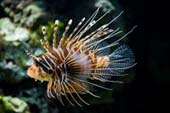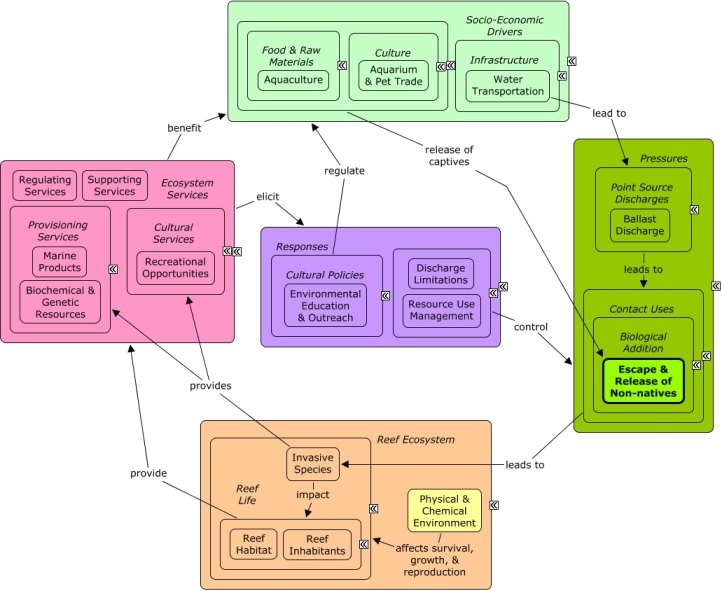ReefLink Database

Escape & Release of Non-natives
The Escape and Release of Non-Natives pertains to the introduction of non-native and potentially invasive species into the coral reef ecosystem.
CMap

CMap Description
The activities of socio-economic drivers can create biological additions into the reef ecosystem. Non-native and invasive species may be introduced accidentally by collectors of exotic species (e.g., the aquarium and pet trade), or from ballast water discharges from international ships. Non-native and invasive species compete with native species. Aquaculture facilities also pose a risk of accidentally releasing cultured species into wild populations. Many of the same socio-economic sectors that pose a risk of introducing invasive species benefit directly from goods and services, such as genetic diversity or marine products, provided by the reef. Ballast discharges can be controlled through point-source regulations. Environmental education can be used to educate individuals about accidental or intentional introductions of exotic species.Citations
| Citation | Year | Study Location | Study Type | Database Topics |
|---|---|---|---|---|
| Cote, I. M. and A. Maljkovie. 2010. Predation rates of Indo-Pacific lionfish on Bahamian coral reefs. Marine Ecology Progress Series 404:219-225. | 2010 | South & Central America; US Pacific & Hawaii; Bahamas; Caribbean | Field Study & Monitoring | Escape & Release of Non-natives; Fish |
| Ruiz-Carus, R., R. E. Matheson Jr., D. E. Roberts Jr., and P. E. Whitfield. 2006. The western Pacific red lionfish, Pterois volitans (Scorpaenidae), in Florida: Evidence for reproduction and parasitism in the first exotic marine fish established in state waters. Biological Conservation 128:384-390. | 2006 | Florida; US Pacific & Hawaii | Review | Escape & Release of Non-natives; Fish; Invasive Species |
| Semmens, B. X., E. R. Buhle, A. K. Salomon, and C. V. Pattengill-Semmens. 2004. A hotspot of non-native marine fishes: Evidence for the aquarium trade as an invasion pathway. Marine Ecology Progress Series 266:239-244. | 2004 | Florida | Aquarium & Pet Trade; Aquarium Stock; Ballast Discharge; Environmental Education & Outreach; Escape & Release of Non-natives; Fish; Invasive Species; Shipping, Storage, & Warehousing; Social Organizations | |
| National Research Council. 2003. Oil in the sea III: inputs, fates, and effects. National Academy of Sciences, Washington, D.C. | 2003 | Escape & Release of Non-natives; Mitigation | ||
| Hutchings, P. A., R. W. Hilliard, and S. L. Coles. 2002. Species introductions and potential for marine pest invasions into tropical marine communities, with special reference to the Indo-Pacific. Pacific Science 56:223-233. | 2002 | South & Central America; US Pacific & Hawaii; Australia; Panama; Papua New Guinea; Indonesia; Philippines; Caribbean | Ballast Discharge; Discharges; Docks & Marinas; Escape & Release of Non-natives; Finfish Harvest; Invasive Species; Large Ships; Military; Pathogens; Ports & Harbors; Shipping, Storage, & Warehousing; Small Boats | |
| Paulay, G., L. Kirkendale, G. Lambert, and C. Meyer. 2002. Anthropogenic biotic interchange in a coral reef ecosystem: A case study from Guam. Pacific Science 56:403-422. | 2002 | US Pacific & Hawaii; Micronesia; Guam | Ballast Discharge; Complex Habitat & Resources; Docks & Marinas; Escape & Release of Non-natives; Invasive Species; Military; Ports & Harbors; Tourism & Recreation | |
| Whitfield, P. E., T. Gardner, S. P. Vives, M. R. Gilligan, W. R. Courtenay Jr., G. C. Ray, and J. A. Hare. 2002. Biological invasion of the Indo-Pacific lionfish Pterois volitans along the Atlantic coast of North America. Marine Ecology Progress Series 235:289-297. | 2002 | Florida; US Pacific & Hawaii; US East Coast (NC, SC, GA); Atlantic Ocean; Bermuda | Ballast Discharge; Escape & Release of Non-natives; Fish; Invasive Species |
Management Options
| Management Option | Description | Sources | Database Topics |
|---|---|---|---|
| Agriculture & Aquaculture: Bivalve Aquaculture Biofouling Control | These management options reduce, clean or remove biofouling organisms and other waste from bivalve production areas while minimizing environmental risk. Aquaculture shellfish production requires adequate food availability and water of dependable quantity and quality. Aquaculture operations and gear must have a minimal adverse impact on the surrounding water, plant, animal and human resources. Biofouling is detrimental to shellfish production, increasing exposure to pathogens, reducing the available food stuffs, and increasing organic loading. Only environmentally appropriate biofoul control methods should be used, and fouling organisms and algae should be disposed of appropriately to avoid local degradation. | Natural Resources Conservation Service. 2011. National Handbook of Conservation Practices. U.S. Department of Agriculture. Natural Resources Conservation Service. 2011. Conservation Practice Standard: Bivalve Aquaculture Gear and Biofouling Control. CODE 400, USDA. |
Algae; Aquaculture; Arthropods; Artificial Habitat; Biological Addition; Biological Harvest; Bivalves; Chemical Variables; Discharge Limitations; Domestic Animal Waste; Escape & Release of Non-natives; Finfish & Shellfish Stock; Food & Energy Policies; Food & Raw Materials; Improved Technology; Invertebrate Harvest; Lobster, Crab, & Shrimp; Molluscs; Non-point Source Controls; Nutrient & Contaminant Processing; Octopus & Squid; Point & Mobile Source Controls; Snails & Conch; Supplemental Feeding |
| Landuse Management: Household Landscaping Best Management Practices | Homeowners manipulate the visible features of the land surrounding their home through landscaping. This includes flora, fauna, and terrain. Best Management Practices (BMPs) for landscaping include selection of indigenous flora and fauna, landscape irrigation (sprinkler systems etc), stormwater runoff BMPs, reducing water use, integrated pest management, composting, and incorporation of permeable surfaces. | Natural Resources Conservation Service. 2011. National Handbook of Conservation Practices. U.S. Department of Agriculture. Irrigation Association. 2010. Turf and Landscape Irrigation Best Management Practices. |
Applied Chemicals; Biological Addition; Building & Home Construction; Chemical Variables; City Planning; Discharge Limitations; Environmental Education & Outreach; Escape & Release of Non-natives; Existence Value & Sense of Place; Fertilizer & Pesticide Use; Impervious Surfaces; Landscape Conservation & Restoration; Landscaping & Household Services; Landuse Management; Non-point Source Controls; Non-point Source Runoff; Nutrients; Sediment; Shelter; Supplemental Feeding; Toxics; Waterborne Discharges |
| Regulatory Review and Development: Evaluate Exotic Species Regulations | The release of exotic species is already prohibited in many areas. Often these regulations do not consider exotic species released in ballast water. Regulations on discharge of ship ballast water containing exotic or non-indigenous species is therefore an area for regulatory improvement. | NOAA Marine Sanctuary Program. 2007. Florida Keys National Marine Sanctuary revised management plan. National Ocean Service, Key West, FL. |
Ballast Discharge; Biocriteria; Biological Addition; Boating Regulations; Discharge Limitations; Escape & Release of Non-natives; Invasive Species; Point & Mobile Source Controls; Point Source Discharges; Transportation Policies; Water Transportation; Waterborne Discharges |
| Regulatory Review and Development: Evaluate Aquaculture/Mariculture Regulations | This will help determine if there is a need to establish mariculture operations regulations and proceed accordingly. This would help satisfy the commercial demand for fish while taking pressure off of the wild species. Such regulations should consider where, when and what species of mariculture are allowable. The environmental impact mariculture has can vary depending on current, depth and distance to land, making location and even season important. The species being cultured is also an important consideration, especially if they are non-native or different genetically from the local natural population as escapes may occur. | NOAA Marine Sanctuary Program. 2007. Florida Keys National Marine Sanctuary revised management plan. National Ocean Service, Key West, FL. NEPA. 1998. MARICULTURE DRAFT POLICY AND REGULATION NATURAL RESOURCES CONSERVATION AUTHORITY COASTAL ZONE MANAGEMENT DIVISION. National Environment & Planning agency. |
Agriculture, Aquaculture, & Forestry Policies; Aquaculture; Biological Addition; Biological Harvest; Commercial Fisheries; Contact Uses; Designated Uses; Domestic Animal Waste; Escape & Release of Non-natives; Food & Energy Policies; Food & Raw Materials; Invasive Species; Resource Use Management; Supplemental Feeding |
| Resource Use Management: Prevent Introduction of Invasive Species | Preventing the introduction of invasive species involves public awareness of the invasive species, minimizing modes and prone areas for invasion, and detecting small populations for early eradication. Some common modes of terrestrial transportation include livestock and domestic animals, mowing equipment, and firewood. Clean equipment before transport to a new location. Remove soil from plants, and plant bare-root. Use high grade seed and weed free livestock feeds. Reduce opportunities for invasive plants by keeping native plant populations strong and healthy and seeding in cover crops to reduce barren soil. | Agriculture, Aquaculture, & Forestry Policies; Aquarium & Pet Trade; Ballast Discharge; Biological Addition; Construction Codes & Projects; Discharge Limitations; Environmental Education & Outreach; Escape & Release of Non-natives; Invasive Species; Landscape Conservation & Restoration; Landscaping & Household Services; Manufacturing & Trade; Transportation; Water Transportation | |
| Restoration: Removal of Invasive Algae | Benthic organisms on reefs maintain a delicate balance competing for space. In many areas, the competition between coral and algae has fallen out of balance due to confounding factors. Factors such as decreased herbivorous fish and invertebrates, and invasive algae species have allowed faster growing algae to take over many reefs, often growing into smothering mats that cover and kill coral. In Hawaii, there has been some success physically removing invasive algae such as Kappaphycus using underwater vacuums extended down from barges or volunteer events in shallower areas. | The Nature Conservancy. 2010.Two Million Pounds of Invasive Algae Removed From Maunalua Bay. (not cited) |
Algae; Aquaculture; Biological Addition; Biological Harvest; Biological Monitoring & Restoration; Biological Monitoring, Mapping, & Scientific Research; Calcareous Macroalgae; Collaboration & Partnering; Coral; Coralline Algae; Decision Support; Ecosystem Monitoring & Restoration; Escape & Release of Non-natives; Fishing & Harvesting Management; Fishing Sector; Fleshy Macroalgae; Hydrocoral; Invasive Species; Large Herbivorous Fish; Octocoral; Reef Habitat; Skeletal Coral; Small Herbivorous Fish; Stony Coral; Turf Algae; Wetland & Reef Restoration; Zooxanthellae |
Laws
| Legal Citation | Purpose of Law | Management Organization | Database Topics |
|---|---|---|---|
| Exec. Order No. 13112, Invasive Species, 68 Federal Register 6183 (1990). | Federal agencies are directed to prevent the introduction of invasive species, detect and rapidly respond to control populations of such species in a cost effective and environmentalyy sound manner, accurately monitor invasive species, provide for restoration of native species and habitat conditions, conduct research to prevent introduction and to control invasive species, and promote public education on invasive species and the means to address them. Application to Coral Reefs: Legislative Actions:No enforcement provisions. Federal agencies are encouraged to prevent the introduction, detect and respond to control, monitor, and conduct research of invasives. Secretary of Interior established an "Invasive Species Council" to address invasive species issues. Comments: |
Federal Agencies Jurisdiction: United States |
Collaboration & Partnering; Designate Protected Species; Environmental Education & Outreach; Environmental Monitoring, Mapping, & Scientific Research; Escape & Release of Non-natives; Existence Value & Sense of Place; Invasive Species; Political Pressure; Remediation |
